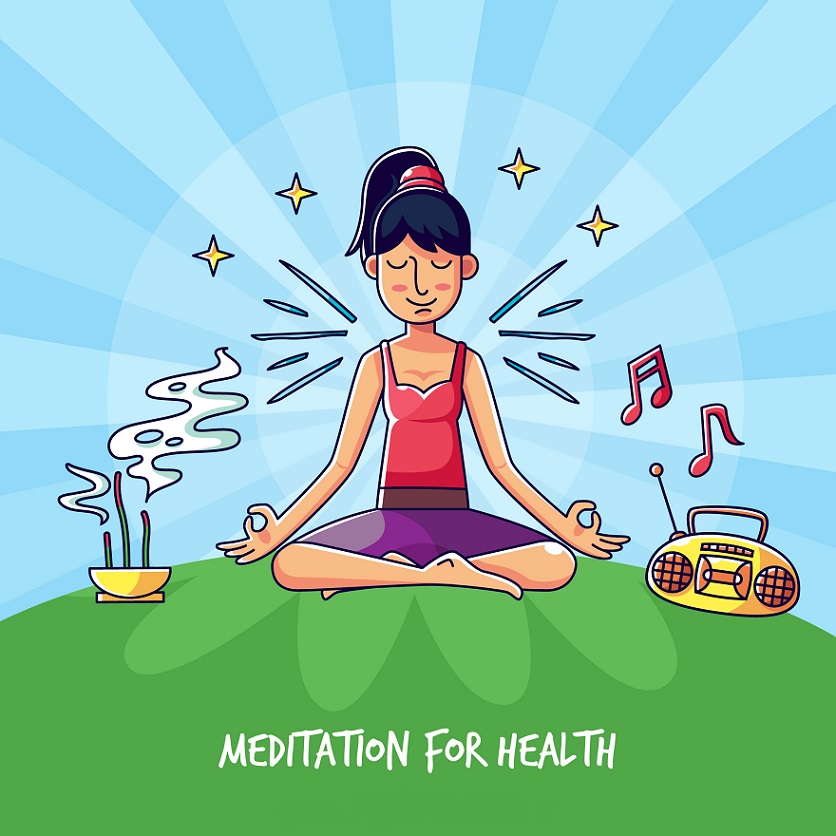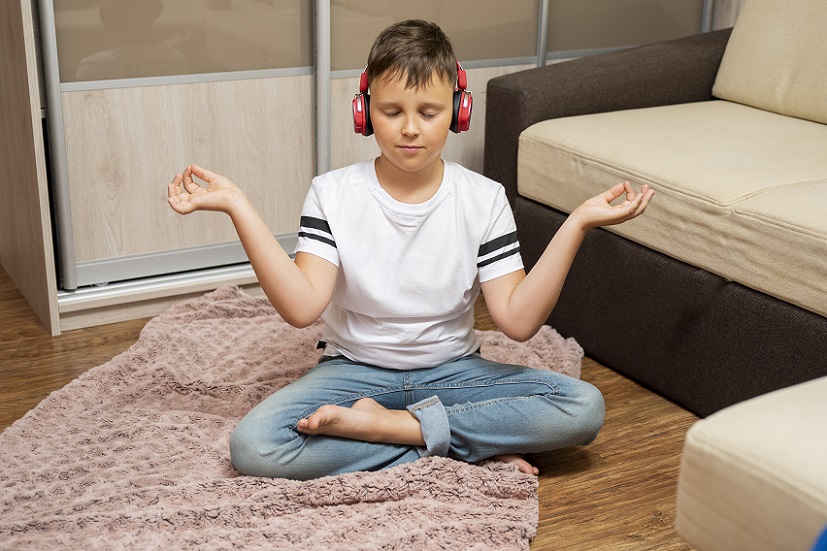Meditation Music For Stress Relief:
Many early practitioners or individuals new to the practice, assume that meditation is a silent practice. While this is true in some cases, not all meditation requires you to practice silently. In fact, there are many forms of meditation that incorporate audio as a form of relaxation. Today we’ll explore meditation music for stress relief, specifically.
Guided meditations are one way you can add sound to your practice. Words can help you more easily focus your mind on the present moment. However, if you want to experience a Zen-like session, try using meditation music for stress-relief.
Related Article: Sound Therapy Benefits: The Healing Power of Harmonious Tones

Interesting Research!
Over recent years, sound and music have both been studied quite extensively for their use as types of therapy for psyche. Music has even been incorporated into Intensive Care Units (ICU’s) in hospitals as it is a “reliable and efficacious treatment” when it comes to stress-relief. Music has the ability to abate the stress response.
Another study looked at the use of lullaby’s sung by parents and instruments in Neonatal ICU’s. In conclusion, all of which slowed babies heart rates. Singing, increased the time babies stayed quietly alert, and sucking behaviors improved with the use of a gato box.
Studies have even linked the use of music in combination with other post-surgical interventions in surgical patients, to help reduce pain.
Point being, music is known for its calming and relaxing properties. When you use meditation music specifically, these effects may help to elicit calm, but also help focus the mind.
In this article, we’ll talk more about how you can use meditation music to reduce stress. We’ll also discuss ways this form of music can help improve your meditation session(s)!
You can also learn more specifically about “sound bath meditation” in a post here, where using specific sounds can help strengthen your practice.
I. Meditation Music Calms The Mind And The Body Quickly
In general, music is a great way to relieve stress from both the mind and the body in the short term. Studies have shown that music can improve your mood, slow down your breathing, and even lower blood pressure. Certain tempos of music can create specific emotions and feelings while you listen to them.

For example, a low tempo piano song or a melody with chimes and water sounds, could make you feel peaceful and more at ease. Some of these effects can be achieved with very little conscious effort on your part. Of course, the effectiveness of sound may vary from person to person.
Coupled with meditation, relaxing meditation music may help to increase these benefits. Meditation promotes further relaxing effects through a number of techniques. This includes progressive breathing and mindfulness.
When you choose to do these meditation techniques with music, you may be able to more actively relieve stress throughout daily practices.
One such type of “music” used Tibetan singing bowls in a 2016 study, and it’s effectiveness on mood, anxiety and pain. In conclusion, left participants feeling significantly less tension, anger, fear and depressed mood.
Positive effects of music therapy has even been noted in terminally ill cancer patients, as well.
We’re all looking for ways to cut back on high levels of stress. Indeed, meditation coupled with music, may just be an alternative way to unwind after a hard day of work!
II. Meditation Music Helps Beginners Get Into Meditation More Easily
If you’re new to meditation, music can be especially helpful to your practice. It is easy to lose concentration and let your mind drift, when you first begin the practice of meditating.
Adding meditation music to your practice can change the outcomes of meditation for you. As beforementioned, adding meditation music, may result in “de-stressing” much quicker. Furthermore getting you to “that place” much more effectively.

In fact, one study showed that music with a slower tempo, had the ability to promote a more calm, meditative state.
This can be important during the beginning of a meditation session. You want to be able to quiet your mind and focus better on the present moment. Music may help certain individuals get to their “calm”, faster or more effectively.
III. What Kind of Meditation Music Can You Try?
Meditation music can be filled with songs from a mix of genres. Typically, people imagine Zen type music with water sounds and airy loots. Rightly so, as these have proven to be effective genre’s or sounds to use during your practice.
However, meditation music for stress relief, is not limited to one type of music or sound.

Music, can have chanting included. Oftentimes, a certain note is sung for a duration of time, or a meaningful phrase is repeated over and over. In contrast, regular classical type music can be used for meditation, as well. Nature sounds are popular, with or without instruments.
Other forms of music include, ambient music, binaural beats, monaural beats, and isochoric tones.
How You Can Meditate With Music (Steps)
Meditation with music can be done in a variety of ways. Let’s go over some simple and easy ways to meditate, along with relaxing music/beats and/or sounds.
How long you choose to meditate is ultimately up to you. However, we’d recommend as a beginner, to follow a guided meditation session with short durations (5-15 minutes). In fact, if there is a set of music, sounds or beats that last a few minutes, that could be a good place to start.

You can also find local classes and such, where an instructor may use sounds, like in sound bath meditation, and as voice to help walk your through your first session.
Step 1: Pick Out Your Music
Before you start meditating, you’ll want to have a song/sounds chosen. You don’t want to be fiddling with your phone or devices as you meditate or right before you begin, as your focus should be entirely on the upcoming session. This can distract you from the task at hand.
Again, you don’t have to necessarily choose music that is advertised as meditation music. Classical music or slow tempo electronic music can be used during meditation, much of the selection, is subjective. You could even choose several different types of sounds or genres and see which one suits you best.
With that being said, the music you listen to when going for a run or up-tempo music used during vigorous exercise, is most likely not the same you’ll listen to during meditation. Generally, something that is more soothing, calming and is going to help you relax the mind, is best.
Step 2: Find A Comfortable Position and Location
Once you’ve picked out your music, it’s time to begin the relaxation process. You’ll want to assume a comfortable position that you can hold for prolonged periods of time. Again, meditation can take many forms.
Some people might like to sit down cross-legged, while others find it easier to sit upright in a chair. Some may need the use of a meditation cushion for alignment and for comfort purposes, while some may not.
What matters is that you’re comfortable and feel relaxed, so your mind does not focus any attention on aches and/or pains.
In addition, try to find a quiet spot to meditate. You don’t want to be disturbed by outside sounds or people who might cause your session to become distracted.
Here are some other meditation supplies that may be helpful!
Step 3: Take Inventory of Your Senses and Relax Into Your Body and Breathe
After finding a quiet spot and comfortable position, you’ll want to start-up your music and begin relaxing your body. Sit with a straight back, and let your shoulders rollback, as you don’t want to be tense, or hunched over. If seated on the floor, a cushion or blanket under your backside, may help with alignment of your hips and spine. Close your eyes and begin to relax your muscles.
If you’re lying down (typically for sound bath meditation), or seated, start to scan and feel for tense parts of your body. Gradually let go and let yourself sink into the space you are inhabiting. Scan over your entire body, one body part at a time, feel the temperature of the room, and the sensation of your body in its chosen posture.
The breath should be a main focus. Breathe in deeply and exhale in a measured tempo. Try alternating 4 seconds in, and 8 seconds out.
Step 4: Start Focusing In On Your Music
When you feel yourself relaxing, you can begin focusing on the music you chose. Music will help anchor you into your meditation. For example, if you start thinking about something that happened today, or a stray thought crops up, you can hone in on the music playing instead of the distracting thought or memory. Use the music as a way to bring your attention back to the present moment.

Practice redirecting your train of thought from various distractions, to the music. The more you can really listen to the music and the sense it evokes in your body, the deeper you may sink into your session.
Step 5: Let Go And Be In The Moment
The last thing you’ll want to do as you meditate, is attempt to fully let go. This can seem like a vague step, but it’s actually really simple. Meditation is all about living in the present moment, meditating with music does not change this. As you go about your practice, keep trying to let go. Let go of unwanted thoughts of the past and the future.
Let go of everything, but the moment you’re inhabiting and the music you’re listening to. In this way, you can fully de-stress yourself and go about your day with clarity, and hopefully better focus. In essence you’re training or retraining your mind on how to deal with life in a different, more calming approach.
Finals Thoughts One Meditation Music For Stress Relief!
Hopefully, these steps will help you start practicing meditation with relaxing music.
Above all, be patient with yourself. Meditation may not be something that you are good at right away. It takes dedicated time and effort to master. Don’t get frustrated at yourself if you can’t meditate for long stretches of time. In reality, you’ll want to start out small and build-up your practice gradually.
In addition, we recommend trying out different music to see what works best for you. Some music or sounds, might be more relaxing for you than others!
References:
- https://www.music2meditate.org/how-to-use-music-to-meditate—three-essential-tips.html
- https://www.wildmind.org/background/can-anyone-meditate/music
- https://journals.lww.com/nursing/Citation/2017/06000/PAIN_MANAGEMENT_Music_therapy_relieves_spinal_pain.17.aspx
- https://www.apa.org/monitor/2013/11/music
- https://www.sciencedirect.com/science/article/abs/pii/S0883944116300934?via%3Dihub
- https://www.ncbi.nlm.nih.gov/pmc/articles/PMC5871151/
- https://pubmed.ncbi.nlm.nih.gov/27096963/
- https://asa.scitation.org/doi/abs/10.1121/1.4902001
- https://www.liebertpub.com/doi/10.1089/jpm.2015.0384



